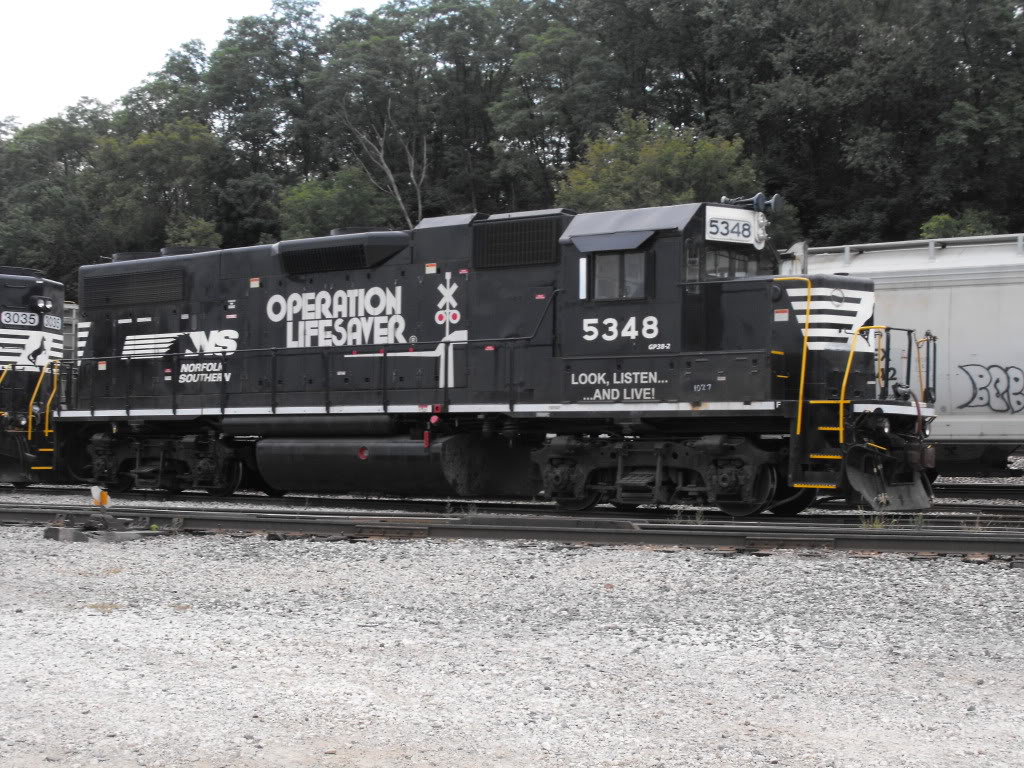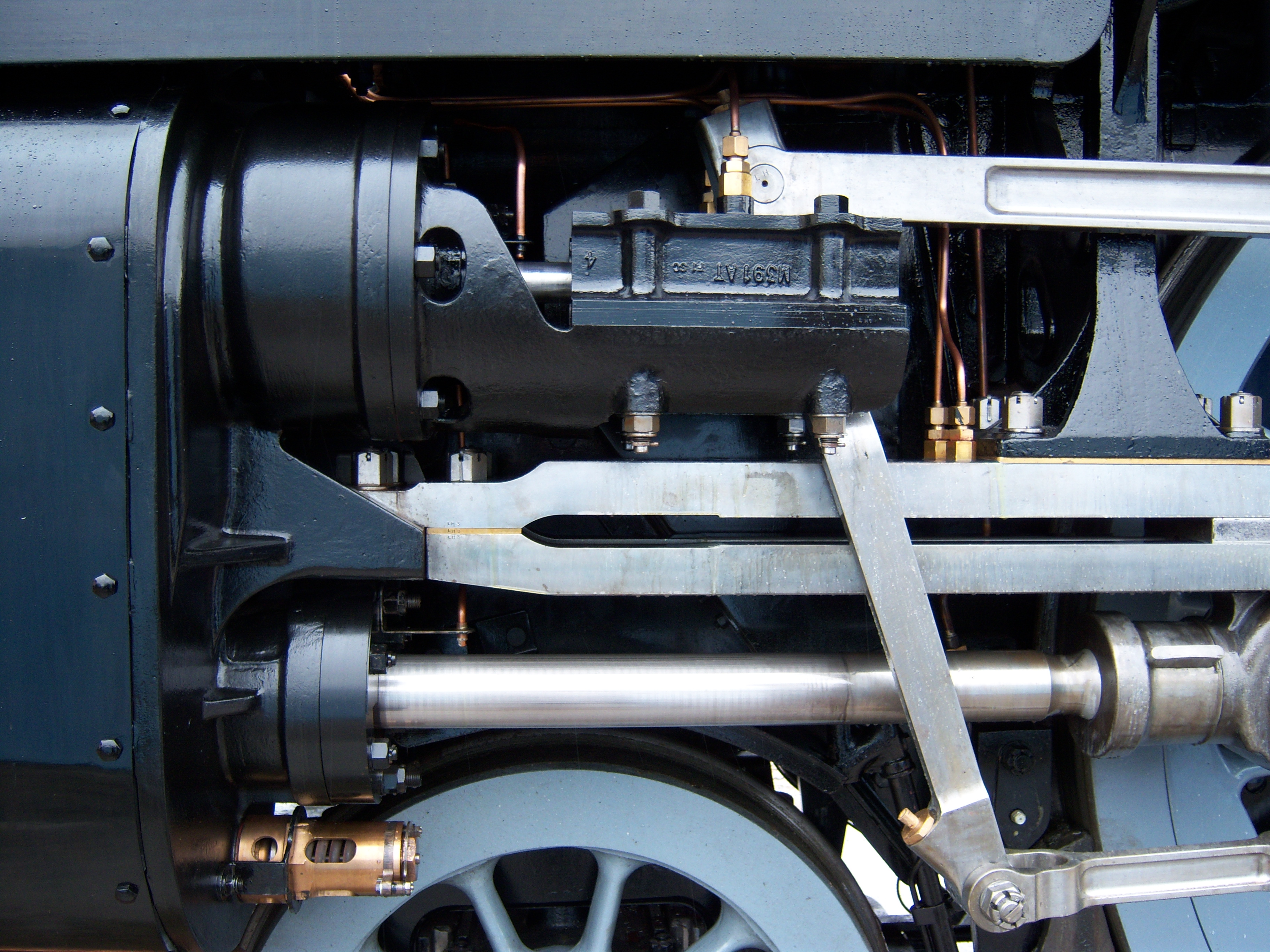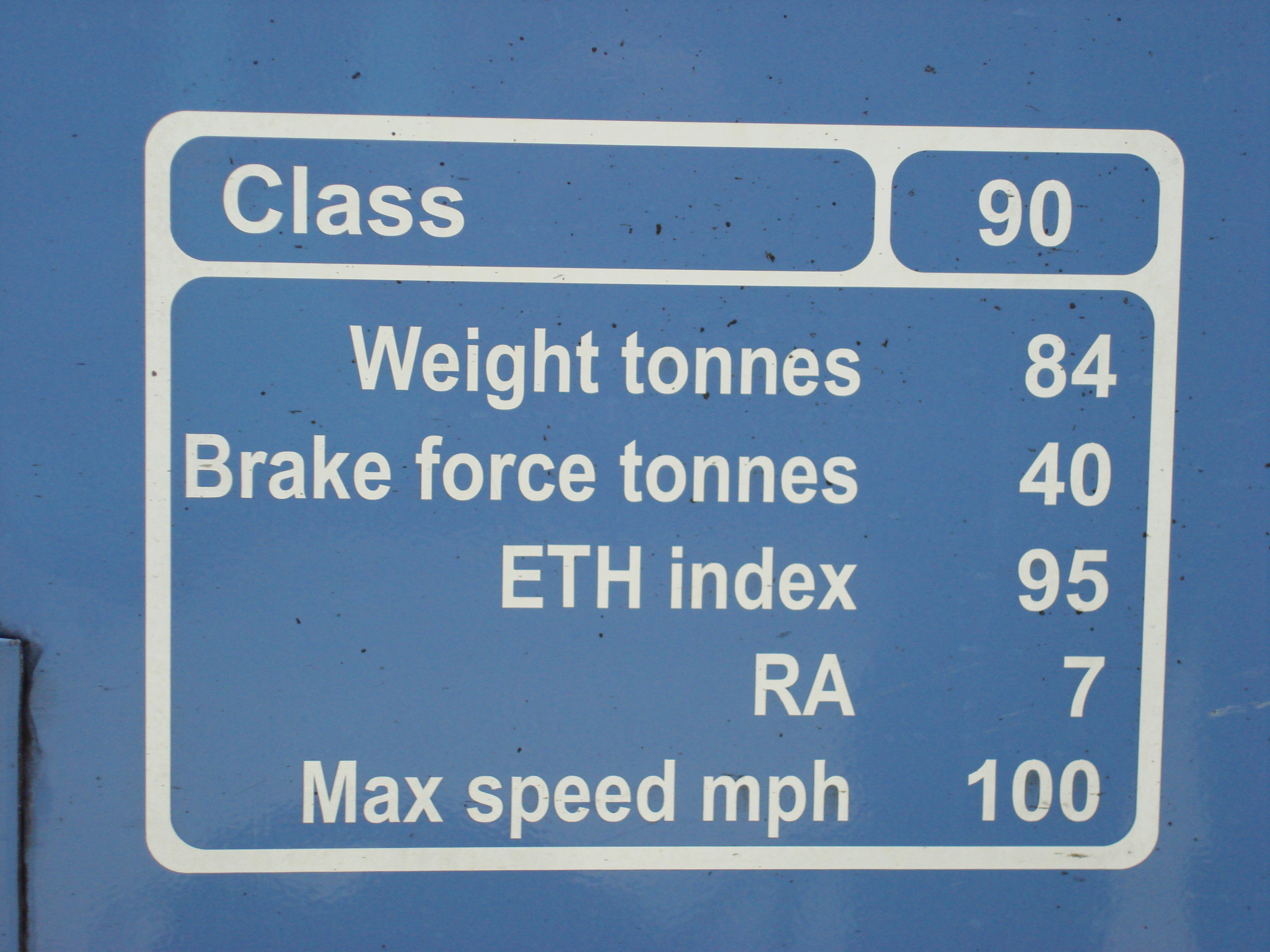|
Counter-pressure Brakes
The counter-pressure brake (German: ''Gegendruckbremse''), also named the Riggenbach counter-pressure brake after its inventor, Niklaus Riggenbach, is a dynamic brake, dynamic railway brake on steam locomotives that brakes the locomotive using the driving cylinder (locomotive), cylinders. In doing so it reduces wear and tear and overheating of the driving wheel tyres and brake blocks and enables a continuously high brake force to be applied. The brake works by using the cylinders as air compressors and converting kinetic energy into heat. Steam is emitted during braking but this does not come from the boiler, it is produced by evaporation of water used to cool the cylinders. The main part of the system is piping and regulation of atmospheric air drawn into the cylinders, into which cooling water and oil is injected. Operation To use the cylinders as pumps necessitates complete reversal of the normal gas flow. Atmospheric air is drawn through the steam exhaust and compressed air ejec ... [...More Info...] [...Related Items...] OR: [Wikipedia] [Google] [Baidu] |
Niklaus Riggenbach
Niklaus Riggenbach (21 May 1817 – 25 July 1899) was the inventor of the Riggenbach rack system and the counter-pressure brake. He was also an engineer and locomotive builder. Niklaus Riggenbach, from Rünenberg, Basel-Landschaft, Switzerland, was born in Guebwiller, Alsace. After the death of his father, his mother returned to Basel with her eight young children. At age 16 Riggenbach began an apprenticeship as a mechanic, going abroad after completing his training. In 1837 he found his way to Paris, where he accepted employment. By taking technical courses in night school, he acquired considerable knowledge in mathematics and physics. With the opening of the Paris-St. Germain railroad line in 1839 he found his vocation to build locomotives. In June 1840 he moved to Karlsruhe, Germany, and found employment in the machine works of Emil Kessler. Here he soon rose to managing director and was involved in the construction of no less than 150 locomotives. One of the ... [...More Info...] [...Related Items...] OR: [Wikipedia] [Google] [Baidu] |
Dynamic Brake
Dynamic braking is the use of an electric traction motor as a generator when slowing a vehicle such as an electric or diesel-electric locomotive. It is termed " rheostatic" if the generated electrical power is dissipated as heat in brake grid resistors, and " regenerative" if the power is returned to the supply line. Dynamic braking reduces wear on friction-based braking components, and regeneration lowers net energy consumption. Dynamic braking may also be used on railcars with multiple units, light rail vehicles, electric trams, trolleybuses, and electric and hybrid electric automobiles. Principle of operation Converting electrical energy to the mechanical energy of a rotating shaft (electric motor) is the inverse of converting the mechanical energy of a rotating shaft to electrical energy (electric generator). Both are accomplished through the interactions of armature windings with a (relatively) moving external magnetic field, with the armature connected to an electrical ... [...More Info...] [...Related Items...] OR: [Wikipedia] [Google] [Baidu] |
Steam Locomotives
A steam locomotive is a locomotive that provides the force to move itself and other vehicles by means of the expansion of steam. It is fuelled by burning combustible material (usually coal, oil or, rarely, wood) to heat water in the locomotive's boiler to the point where it becomes gaseous and its volume increases 1,700 times. Functionally, it is a steam engine on wheels. In most locomotives, the steam is admitted alternately to each end of its cylinders, in which pistons are mechanically connected to the locomotive's main wheels. Fuel and water supplies are usually carried with the locomotive, either on the locomotive itself or in a tender coupled to it. Variations in this general design include electrically-powered boilers, turbines in place of pistons, and using steam generated externally. Steam locomotives were first developed in the United Kingdom during the early 19th century and used for railway transport until the middle of the 20th century. Richard Trevithick bui ... [...More Info...] [...Related Items...] OR: [Wikipedia] [Google] [Baidu] |
Cylinder (locomotive)
The cylinder is the power-producing element of the steam engine powering a steam locomotive. The cylinder is made pressure-tight with end covers and a piston; a valve distributes the steam to the ends of the cylinder. Cylinders were cast in iron and later made of steel. The cylinder casting includes other features such as (in the case of the early Rocket locomotive) valve ports and mounting feet. The last big American locomotives incorporated the cylinders as part of huge one-piece steel castings that were the main frame of the locomotive. Renewable wearing surfaces were needed inside the cylinders and provided by cast-iron bushings. The way the valve controlled the steam entering and leaving the cylinder was known as steam distribution and shown by the shape of the indicator diagram. What happened to the steam inside the cylinder was assessed separately from what happened in the boiler and how much friction the moving machinery had to cope with. This assessment was known as "e ... [...More Info...] [...Related Items...] OR: [Wikipedia] [Google] [Baidu] |
Driving Wheel
On a steam locomotive, a driving wheel is a powered wheel which is driven by the locomotive's pistons (or turbine, in the case of a steam turbine locomotive). On a conventional, non-articulated locomotive, the driving wheels are all coupled together with side rods (also known as coupling rods); normally one pair is directly driven by the main rod (or connecting rod) which is connected to the end of the piston rod; power is transmitted to the others through the side rods. On diesel and electric locomotives, the driving wheels may be directly driven by the traction motors. Coupling rods are not usually used, and it is quite common for each axle to have its own motor. Jackshaft drive and coupling rods were used in the past (e.g. in the Swiss Crocodile locomotive) but their use is now confined to shunting locomotives. On an articulated locomotive or a duplex locomotive, driving wheels are grouped into sets which are linked together within the set. Diameter Driving wheels ... [...More Info...] [...Related Items...] OR: [Wikipedia] [Google] [Baidu] |
Brake Force
Brake force, also known as Brake Power, is a measure of braking power of a vehicle. Railways In the case of railways, it is important that staff are aware of the brake force of a train so sufficient brake power will be available to bring the train to a halt within the required distance from a given speed. In simple terms the brake force of a train should be relative to the sum of the brake force that can be exerted by all the vehicles in the train relative to the weight of the train, excluding problems that may occur such as wheels locking and sliding under braking. Modern freight wagons typically have brakes that can be operated from the locomotive, these are sometimes referred to as ''fitted'' freights. Older wagons typically were not fitted with brakes that could be operated from the locomotive, sometimes these are referred to as ''unfitted freights''. These unfitted freights would typically have brake vans attached to provide additional braking force and operated at a red ... [...More Info...] [...Related Items...] OR: [Wikipedia] [Google] [Baidu] |
Grade (slope)
The grade (also called slope, incline, gradient, mainfall, pitch or rise) of a physical feature, landform or constructed line refers to the tangent of the angle of that surface to the horizontal. It is a special case of the slope, where zero indicates horizontality. A larger number indicates higher or steeper degree of "tilt". Often slope is calculated as a ratio of "rise" to "run", or as a fraction ("rise over run") in which ''run'' is the horizontal distance (not the distance along the slope) and ''rise'' is the vertical distance. Slopes of existing physical features such as canyons and hillsides, stream and river banks and beds are often described as grades, but typically grades are used for human-made surfaces such as roads, landscape grading, roof pitches, railroads, aqueducts, and pedestrian or bicycle routes. The grade may refer to the longitudinal slope or the perpendicular cross slope. Nomenclature There are several ways to express slope: # as an ''angle'' of inc ... [...More Info...] [...Related Items...] OR: [Wikipedia] [Google] [Baidu] |
Rack Railway
A rack railway (also rack-and-pinion railway, cog railway, or cogwheel railway) is a steep grade railway with a toothed rack rail, usually between the running rails. The trains are fitted with one or more cog wheels or pinions that mesh with this rack rail. This allows the trains to operate on steep grades above 10%, which is the maximum for friction-based rail. Most rack railways are mountain railways, although a few are transit railways or tramways built to overcome a steep gradient in an urban environment. The first cog railway was the Middleton Railway between Middleton and Leeds in West Yorkshire, England, United Kingdom, where the first commercially successful steam locomotive, ''Salamanca'', ran in 1812. This used a rack and pinion system designed and patented in 1811 by John Blenkinsop. The first mountain cog railway was the Mount Washington Cog Railway in the U.S. state of New Hampshire, which carried its first fare-paying passengers in 1868. The track was comple ... [...More Info...] [...Related Items...] OR: [Wikipedia] [Google] [Baidu] |
Kahlenberg
The Kahlenberg () is a mountain () located in the 19th District of Vienna, Austria (Döbling). General The Kahlenberg lies in the Vienna Woods and is one of the most popular destinations for day-trips from Vienna, offering a view over the entire city. Parts of Lower Austria can also be seen from ''Stefaniewarte'' at the peak. Next to Stefaniewarte is a 165-meter high steel tower that serves as the transmitter for the ORF, the Austrian Broadcast Corporation. Two terraces are located on the mountain: one at a small church called St. Josef and one at a restaurant built in the 1930s by architect Erich Boltenstern. Parts of the restaurant and a nearby abandoned hotel have been torn down and replaced by a modern restaurant and Modul University Vienna, a private university established in 2007, focusing on Social and Economic Development, in particular in the areas of tourism, information technology and public governance. The demolition was opposed by the local historical society and by s ... [...More Info...] [...Related Items...] OR: [Wikipedia] [Google] [Baidu] |
Snowdon Mountain Railway
The Snowdon Mountain Railway (SMR; cy, Rheilffordd yr Wyddfa) is a narrow gauge rack and pinion mountain railway in Gwynedd, north-west Wales. It is a tourist railway that travels for from Llanberis to the summit of Snowdon, the highest peak in Wales. The SMR is the only public rack and pinion railway in the United Kingdom, and after more than 100 years of operation it remains a popular tourist attraction, carrying more than 140,000 passengers annually. The line is owned and operated by Heritage Great Britain, operators of several other tourist attractions in the United Kingdom. The railway is operated in some of the harshest weather conditions in Britain, with services curtailed from reaching the summit in bad weather and remaining closed during the winter from November to mid-March. Single carriage trains are pushed up the mountain by either steam locomotives or diesel locomotives. It has also previously used diesel railcars as multiple units. The traditional logo ... [...More Info...] [...Related Items...] OR: [Wikipedia] [Google] [Baidu] |
Countersteam Brake
A countersteam brake is a brake on a steam locomotive that uses the engine (specifically the cylinders) to help brake the locomotive. It uses the working principle of steam cylinders fitted with slide or piston valves such that, by changing the configuration of the valve gear, the motion of the valves is also altered such that they work in opposition to the movement of the pistons. Because of the inertia of a steam locomotive in its initial direction of travel, changing the direction in which the steam cylinders have to work acts first to brake the movement of the connecting rod, which in turn slows the transmission of power to the drive of the locomotive until it stops. The countersteam brake is often confused with the counterpressure brake, which works with air, not steam, and acts as a dynamic brake. Unlike the countersteam brake, the counterpressure brake is permitted to be used as an independent braking system in its own right. Operation The countersteam brake is actuall ... [...More Info...] [...Related Items...] OR: [Wikipedia] [Google] [Baidu] |
Railway Brakes
A railway brake is a type of brake used on the cars of railway trains to enable deceleration, control acceleration (downhill) or to keep them immobile when parked. While the basic principle is similar to that on road vehicle usage, operational features are more complex because of the need to control multiple linked carriages and to be effective on vehicles left without a prime mover. Clasp brakes are one type of brakes historically used on trains. Early days In the earliest days of railways, braking technology was primitive. The first trains had brakes operative on the locomotive tender and on vehicles in the train, where "porters" or, in the United States brakemen, travelling for the purpose on those vehicles operated the brakes. Some railways fitted a special deep-noted brake whistle to locomotives to indicate to the porters the necessity to apply the brakes. All the brakes at this stage of development were applied by operation of a screw and linkage to brake blocks applied ... [...More Info...] [...Related Items...] OR: [Wikipedia] [Google] [Baidu] |





